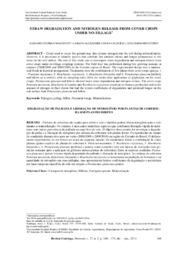Straw degradation and nitrogen release from cover crops under no-tillage.
Straw degradation and nitrogen release from cover crops under no-tillage.
Summary: Crops used to cover the ground may also release nitrogen into the soil during mineralization. However, it is necessary to identify species that combine fast nutrient release and longer permanence of the straw on the soil surface. The aim of this study was to investigate straw degradation and nitrogen release from cover crops under no-tillage cropping systems. The field trial was performed during two growing seasons in summer (2008/2009 and 2009/2010) in the Cerrado region of Brazil. The experimental design was a randomized block in factorial arrangement. Treatments were the combination of five plants (four cover crops species, 1 - Panicum maximum, 2- Brachiaria ruziziensis, 3. Brachiaria brizantha and 4. Pennisetum glaucum [millet], and fallow as a control) with six sampling times (first six weeks after application of glyphosate on the cover crops). Pennisetum glaucum and fallow showed faster straw degradation and nitrogen release. The cover crops Panicum maximum, Brachiaria brizantha and Brachiaria ruziziensis stood out in biomass production and in the amount of nitrogen in their shoots but had the lowest coefficients of degradation and persisted longer on the soil surface than Pennisetum glaucum and fallow.
Publication year: 2014
Types of publication: Journal article
Unit: Embrapa Rice & Beans
Keywords: Milheto, Nitrogênio, Palhada, Planta de cobertura, Planta forrageira, Plantio direto
Observation
Some of Embrapa's publications are published as ePub files. To read them, use or download one of the following free software options to your computer or mobile device. Android: Google Play Books; IOS: iBooks; Windows and Linux: Calibre.
Access other publications
Access the Agricultural Research Database (BDPA) to consult Embrapa's full library collection and records.
Visit Embrapa Bookstore to purchase books and other publications sold by Embrapa.

